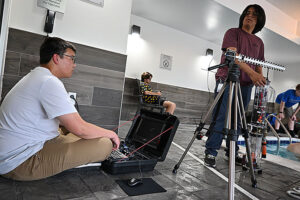By Natalia Rodriguez
The last weekend of June, Soquel High senior Matthew Hofmann traveled with the XAcademy to compete in the 2024 MATE ROV World Championships in Kingsport, Tennessee.
“Our experience at Worlds was anything but smooth,” he said.

After the float failed in the first trial, Nate Hofmann (left) and Orlando Cazales Mendoza returned to the hotel pool to re-write the code. The float worked flawlessly on the second try, yielding a perfect score.
The World Championships gathered teams from Hong Kong to Arizona, challenging students to apply science technology engineering and math skills to seek solutions for real-world problems. MATE ROV stands for Marine Advanced Technology Education and Remotely Operated Vehicle. The competition hosted 78 teams, with 38 challenging the local XAcademy in the Ranger class.
The XAcademy Hephaestus team left the competition with a 3rd place triumph. The victory was well deserved, the students spent countless hours researching and problem-solving.
They are not the only local school making worldwide headlines, the Cabrillo College Seahawk team, competing in the Explorer class, was awarded 1st place.
This was Matthew’s first year with the XAcademy. He joined for the experience and the practice working with a group in his free time. He was part of the float team, which was filled with other first-year students, compared to the ROV team, which had more returning students.
Upon their arrival, students were greeted with 90+ degree heat and a tight workspace. Luckily the hotel had a pool — for the teams to practice in.
Matthew recalls the night before they presented to the judges, several changes to the script had been made and the students could only practice the final version twice before the presentation. Luckily the presentation ran smoothly.
Daniel Fernandez and Ben Hilliard (right), both recent Santa Cruz High graduates, explain their ROV design to a competition judge.
The float team’s objective was to construct a float (from scratch) that would sink to the bottom of the pool twice (aka a profile), return to the surface, and then send the data to a topside that displays depth, pressure, and temperature. The water pressure colliding with the hardware made a successful profile complicated, the difficulty was gathering the data, which was only sent when the float reached the surface. Maintaining a float was crucial, as the name implies.
“The float team was forced to discover and quickly solve any problems we had,” Matthew explained.
During the first demo, the team had a successful ROV; however, the float failed.
The float requirements are updated every year and additional challenges had to be faced. This year, the float had a new buoyance system. When pumping the water to maintain a float, a vacuum was created. The vacuum was a software bypass leading the draining time to be too short.
Fortunately, a second demonstration was coming. The float team changed the drainage timing, the problem was solved and they secured full points.
Matthew intends to continue with robotics.
“The best feeling is when something you put a lot of work into finally works<” he said. “I put in over a hundred hours and to see it work filled me with so much joy.”
Thanks to XAcademy, students have an opportunity for hands-on education. These young minds will be the future of robotics.
•••
To view a video of the team’s engineering presentation: www.youtube.com/watch?v=32fOUJm-Xc4
TOP PHOTO: Back row (from left): Barbara Meister, Tim Sylvester, Uriel Marinez-Uribe, Cole Williams, Amber Williams, Sophia Casaletto, Daniel Fernandez, Orlando Cazales Mendoza, Bennet Menzer, Tim Madsen. Front row (from left): J.D. Hillard, Matt Hofmann, Nate Hofmann, Blaise Benoit-Corey, Max Chen, Kai Herbst, Ben Hillard. Front: Scot Herbst.